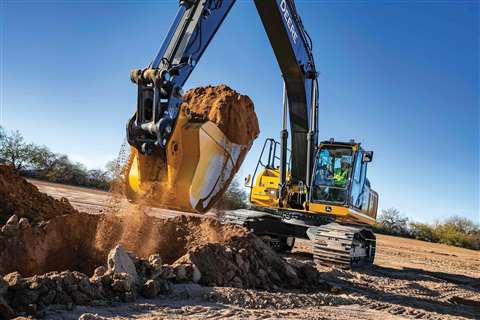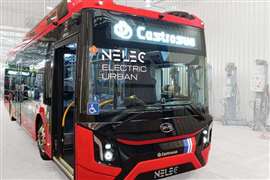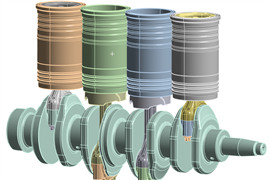Trendlines: Excavators remain lynchpin of construction
02 June 2022
 The North America has a field of participants that are both competitive and ever changing, though well-established companies like Deere have held relatively steady positions. (Photo: John Deere)
The North America has a field of participants that are both competitive and ever changing, though well-established companies like Deere have held relatively steady positions. (Photo: John Deere)
I’m frequently asked which of the more than 30 products we cover each year is my favorite type of machinery. For me, the first picture that comes to mind when that question comes up is the hydraulic excavator.
Excavators are, in my opinion, the lynchpin of all major construction projects, big and small. Epitomized by the standard 20 metric ton machine that most of us see in action every day, they’re the workhorses that define construction machinery.
Along with an array of available attachments, excavators can work in a wide variety of settings; and because of that versatility, they are found in forestry, materials handling, roadbuilding and repair, marine dredging, waste management, demolition, mining and aggregates, utilities and public works, grading, pipelaying and landscaping projects. You might not always see them, but they are out there, working around the clock, in all corners of the world.
The major players
Today’s market in North America has a field of participants that are both competitive and ever changing, even though the well-established companies have held relatively steady positions over the years. Caterpillar, Deere and Komatsu are leading suppliers in this segment, with other significant players such as Volvo, Case, Kubota and Bobcat holding considerable shares of the market.
While most of the current 25 suppliers have been around for decades, changes have taken place within the supplier landscape. Kubota, for example, entered the market with a single machine that produced annual sales in the 500-unit range a little over a decade ago. Last year, the company tripled that figure with sales of more than 1600 units.
Another newcomer that entered the North American market in 2010 was Sany, which has had continued success and reached its highest sales in 2021.
There have been other reshufflings over the years. Most significantly, Deere and Hitachi formally agreed to end their manufacturing/marketing agreement effective this year in February. Deere will purchase the Kernersville, N.C., facility from Hitachi and will continue to manufacture its 13 to 43 metric ton machines there. It is also purchasing the Deere-Hitachi manufacturing facilities in Brazil and Langley, British Columbia, Canada.
Sunward entered the market with crawler excavators and Atlas brought in wheeled excavators, while Manitou (Gehl/Mustang) and Badger exited the scene. This market is dynamic, living and constantly moving.
Innovations abound
Another aspect to the excavator market is how it stays on top of innovation. Volvo was one of the first OEMs to develop all-electric and hybrid excavators, allowing their machines to have lower maintenance schedules, operating costs and in some instances, an expanded range of possible worksites. Electric excavators have zero emissions and can be used indoors or in tight spaces where freshly circulated air is limited. To Volvo’s surprise, demand is present for smaller machines in landscape and utility sectors as well as in demolition and tunnel maintenance.
Adding to tech innovation in the excavator market, Sany Heavy Industry and Huawei jointly introduced the world’s first 5G remote-controlled excavator in 2020, operating an excavator in a mine thousands of miles away. Really large machines, which are much more cumbersome to maneuver, are usually not seen as ideally suited for this type of technology. Doosan, however, has remotely operated a 40-ton excavator in Germany from about 5300 away miles using 5G technology. And here I thought the remote-controlled drone I gave my nephew for his last birthday had a long range!
Construction is key
Sales of hydraulic excavators are primarily driven by construction spending (both residential and nonresidential), and have been holding steady in recent years, save for the COVID year of 2020, which saw a 28% drop in unit sales. That followed an anemic increase in 2019 when unit sales increased 2% year over year. Still, the 31800 machines sold that year was the highest total since we began tracking sales many decades ago, surpassing the previous high of 30400 units in 2006.
More recently, the 31350 units sold in 2021 are again close to the all-time high of two years ago and are indicative of the strong year in regard to construction spending and a fortified excavator market.
Sales in today’s environment, with the ongoing supply chain issues, are limited to production output at the manufacturing level. Because of this, I don’t see sales growing much this year over last. But the elevated levels we’re at today are nothing to sneeze at.
Excavators will, as far as I can tell, never be replaced by any other “like” machine. For this reason, I believe they’ll remain the true icon of construction activity forever.
POWER SOURCING GUIDE
The trusted reference and buyer’s guide for 83 years
The original “desktop search engine,” guiding nearly 10,000 users in more than 90 countries it is the primary reference for specifications and details on all the components that go into engine systems.
Visit Now
STAY CONNECTED




Receive the information you need when you need it through our world-leading magazines, newsletters and daily briefings.
CONNECT WITH THE TEAM












